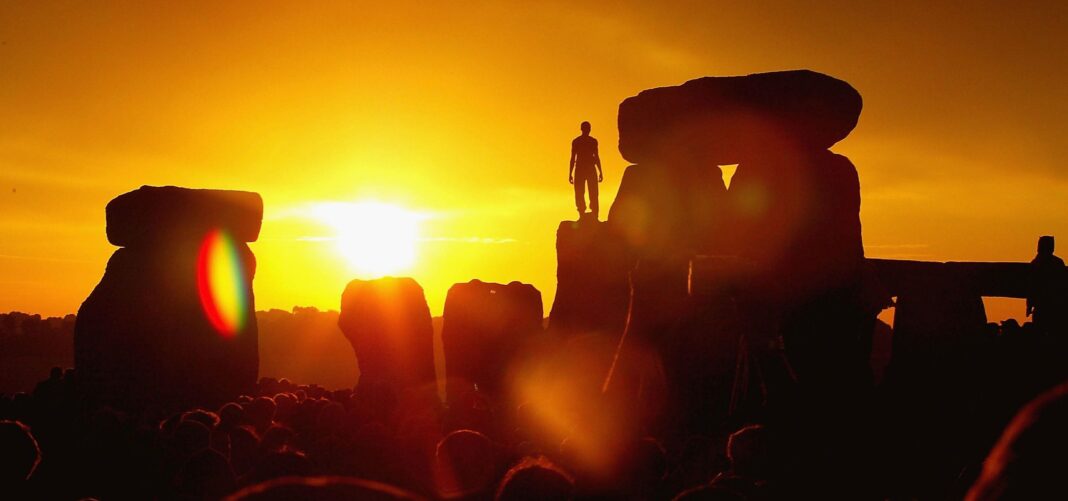Science Don’t Miss June 21’s Jaw-Dropping Summer Solstice Sunrise With Rare Views Of Five Naked-Eye Planets And The Moon Jamie Carter Senior Contributor Opinions expressed by Forbes Contributors are their own. I inspire people to go stargazing, watch the Moon, enjoy the night sky New! Follow this author to improve your content experience. Got it! Jun 16, 2022, 08:00pm EDT | Share to Facebook Share to Twitter Share to Linkedin A reveller greets the sun as it rises above Stonehenge on the day of the Summer Solstice June 21, .
. . [+] 2003 in Wiltshire, England.
More than 30,000 people danced as they greeted the sunrise on summer?s longest day at Stonehenge. Scholars believe the ring of 20-ton stones was built between 3,000 and 1,600 BC as a sacred temple. (Photo by Scott Barbour/Getty Images) Getty Images How do you celebrate June’s summer solstice? Although it’s a global moment, the best way to witness the beginning of summer in the northern hemisphere (and winter in the southern hemisphere) is to see the sunrise.
However, this year the effort of getting out of bed really early is a view you will never forget—a First Quarter Moon close to Jupiter while all five naked-eye planets in the solar system are visible. Here’s everything you need to know about when and where to look: When is the summer solstice? The June solstice is at 09:13 UTC on Tuesday, 21 June, 2022. It’s a global moment that can be translated into these times for North America and Europe: 5:13 a.
m. EDT 4:13 a. m.
CDT 3:13 a. m. MDT 2:13 a.
m. PDT 10:13 a. m.
BST 11:13 a. m. CEST When and where is sunrise on the solstice? That depends on where you are on the planet.
All you need to do is find out what time sunrise is where you are and then make sure you’re in a location with a good view of the eastern horizon. MORE FOR YOU New Research Finds A Connection Between Domestic Violence And These Two Personality Disorders This Scientist Helps Andean Forests And Ecuador’s Women In STEM Exceptional Fossil Preservation Suggests That Discovering Dinosaur DNA May Not Be Impossible Here are the “solstice sunrise” times for a few key locations: New York City: 5:25 a. m.
(solstice is at 5:13 a. m. so it’s the perfect match-up!) Los Angeles: 5:42 a.
m. (solstice is at 2:13 a. m.
) Stonehenge, U. K. : 4:52 a.
m. (solstice is at 10:15 a. m.
) Look to the southeastern sky just prior to sunrise on the summer solstice and you’ll see Saturn, the . . .
[+] Moon, Jupiter, Mars, Venus and Mercury. Stellarium How, when and where to see planets and the Moon on the solstice? Look to the southeastern sky just prior to sunrise on the summer solstice and you’ll see Saturn, the Moon, Jupiter, Mars, Venus and Mercury. The Moon will be at First Quarter.
It’s going to be a special sight—though do be careful when finding Mercury. You may be tempted to use binoculars to find the tiny planet, but that’s not advised if it’s getting close to sunrise (the last thing you want to do is point binoculars at the Sun). Remarkably the five naked-eye planets will be arranged in their natural order from the Sun.
First will be Mercury (the dimmest) and Venus (the brightest)—the two inner planets that orbit the Sun closer than we do on Earth—followed by Mars, Jupiter and then Saturn. Find out when Mercury-rise is where you will watch the solstice from —that’s the time you should star planet-gazing. The axis on which Earth rotates is tilted by 23.
5°, so during our annual orbit around the Sun . . .
[+] different parts of Earth receive sunlight for different lengths of time. At the summer solstice, the northern hemisphere is tilted towards the Sun, so the Sun hangs highest in the sky. So the northern hemisphere gets the full glare of the Sun’s rays, which means the longest day and the warmest temperatures.
getty What is the summer solstice? The longest day and shortest night of the year for the northern hemisphere, June’s solstice is when Earth’s northern axis is tilted towards the Sun, which sits directly over the Tropic of Cancer at precisely 23. 5° north of the equator. That’s as far north as the Sun ever gets, so there’s the most sunlight—and so the longest day.
Exactly the opposite happens in the southern hemisphere, where the June solstice sees the Sun at its lowest in the sky. So below the equator it’s the beginning of winter. Is the summer solstice the start of summer? Opinion is divided on when summer begins in the northern hemisphere.
Although most people think that the northern hemisphere’s summer begins on June 1, that’s merely meteorological summer. Who cares about that?! Astronomical summer—as determined by the precise tilt in Earth’s orbit and its position in the Solar System—begins on the date of June’s solstice. Wishing you clear skies and wide eyes.
Follow me on Twitter or LinkedIn . Check out my website or some of my other work here . Jamie Carter Editorial Standards Print Reprints & Permissions.
From: forbes
URL: https://www.forbes.com/sites/jamiecartereurope/2022/06/16/dont-miss-june-21s-jaw-dropping-summer-solstice-sunrise-with-rare-views-of-five-naked-eye-planets-and-the-moon/



